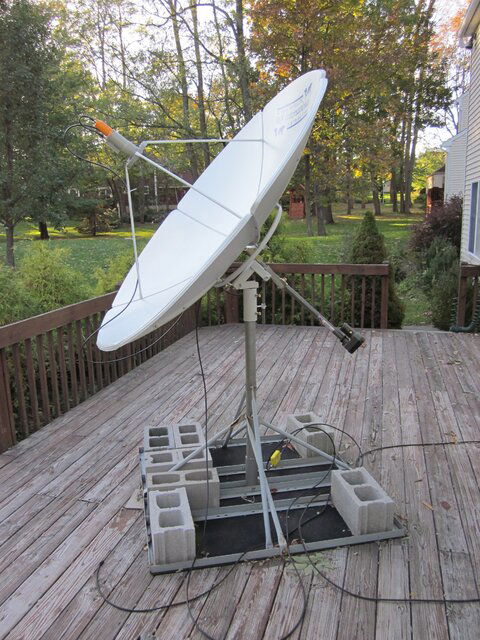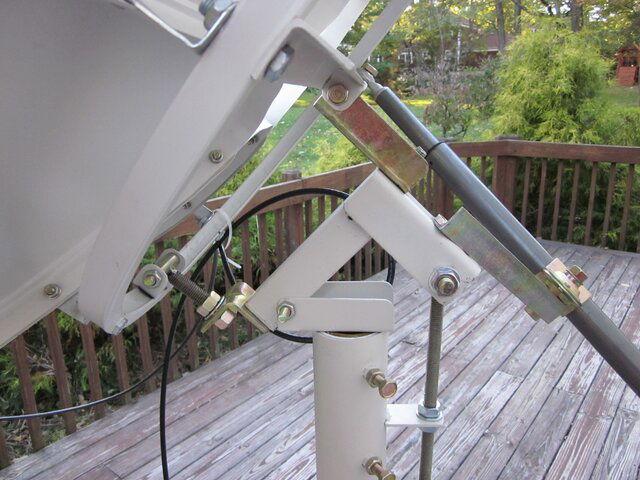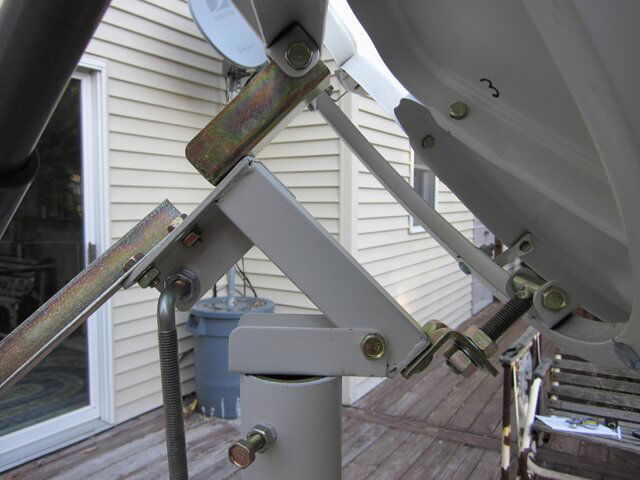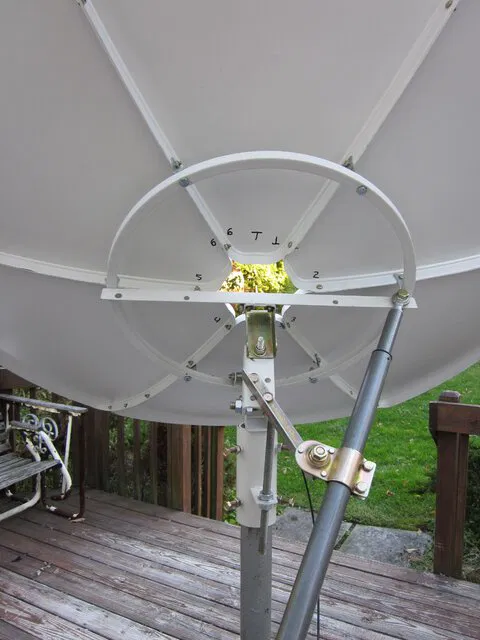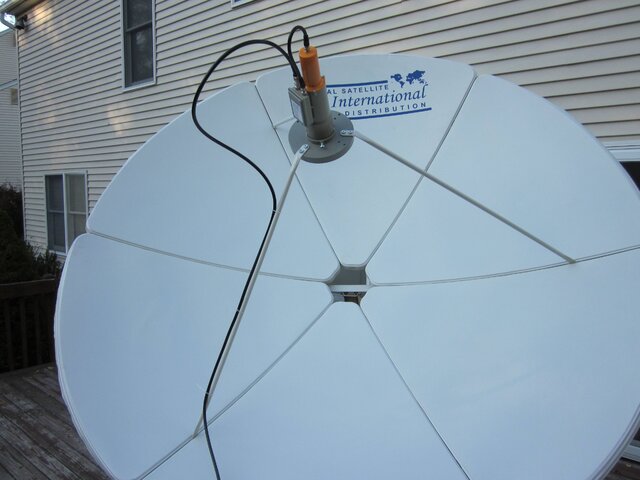WOW!! your trying to use a HH motor instead of an actuator!Let us know if the moter will handle the load and the dish tracks correctly.Had a little free time this afternoon so I did a test fitting. Everything looks good and the dish moves well. This has been a fun project but don't try this unless you are willing to see it not work. As you can see, I decided to go a different direction....
6 foot dish install
- Thread starter dougruss
- Start date
- Latest activity Latest activity:
- Replies 222
- Views 43K
You are using an out of date browser. It may not display this or other websites correctly.
You should upgrade or use an alternative browser.
You should upgrade or use an alternative browser.
- Status
- Please reply by conversation.
WOW!! your trying to use a HH motor instead of an actuator!Let us know if the moter will handle the load and the dish tracks correctly.
Its about 90 up on the deck today and too hot to do much right now. I did plug in the Pansat 2500 and the dish tracks fine from 63W-139W using USALS. Movement (speed) of the 1.8M dish was same as my 1.2M which was previously on the motor. I may have to take it all apart and reposition for optimal LOS and because I'm told I'm, "blocking the window." LOL. Don't people have their priorities? Assuming it works when finished, I'll try and figure out how to make a short video of it tracking.
Had a little free time this afternoon so I did a test fitting. Everything looks good and the dish moves well. This has been a fun project but don't try this unless you are willing to see it not work. As you can see, I decided to go a different direction....
Very cool. Did you just happen to have the fortec back piece or did you purchase that piece for this project?
Very cool. Did you just happen to have the fortec back piece or did you purchase that piece for this project?
i had one from an old dish that I saved which is what initially gave me the idea. unfortunately i couldn't find it and eventually found a used one. I considered using the rear bracket from my WSI 1.2M dish although its a little heavier and then I couldn't use my 1.2M dish for Ku.
I guess its a supply and demand thing but i dont understand why some company dosnt just make a more powerfull HH motor for the larger dishes.Would make life more easier getting rid of the v-box and extra wires.
I guess its a supply and demand thing but i dont understand why some company dosnt just make a more powerfull HH motor for the larger dishes.Would make life more easier getting rid of the v-box and extra wires.
I'd guess it's also a matter of the price of the final "12 footer rated" HH motor. Compared to an actuator, it's a pretty expensive and complex thing. Probably would need more current than a typical receiver can supply, so we'd still have to buy an "interface" box to power the beast. Would be sweet if the Gbox understood USALS as an option.
Actually I'm pretty happy with the Gbox and actuator. It's conceptually quite simple, and easy to troubleshoot.
I guess its a supply and demand thing but i dont understand why some company dosnt just make a more powerfull HH motor for the larger dishes.Would make life more easier getting rid of the v-box and extra wires.
I would purchase one, without hesitation.
That is quite ingenious, I hope it doesn't get too windy though... Are you concerned about the size of the dish and it being mounted on a few cinder blocks? Would hate to see it get blown down.
Had a little free time this afternoon so I did a test fitting. Everything looks good and the dish moves well. This has been a fun project but don't try this unless you are willing to see it not work. As you can see, I decided to go a different direction....
That is quite ingenious, I hope it doesn't get too windy though... Are you concerned about the size of the dish and it being mounted on a few cinder blocks? Would hate to see it get blown down.
I get some wind up there but it is sheltered on one side so don't think it will be an issue. As mentiond, its up now for just a test fitting, ensure motor functions properly and to figure out just where it should be placed on the deck for optimal LOS. When finished, there will be cinder blocks underneath the entire deck mount and 4-6 on top. Other than an earthquake, it won't be moving
I was wondering if it would be okay to flip ITEM # 27 the mounting plate for the actuator straight (vertical to the ground) instead of at an angle. I have noticed if I do so and turn the bracket over I have an almost perfect alignment causing me to not need any washers. Please advise if this okay as once completed I am ready to dig my hole in the ground.
rodm
rodm
Try it out, there's not really a rule here ( and certainly no instructions !) . There are a few principles.
1. We want a straight push-pull of the actuator with minimal side loading.
2. We want the angle of the actuator to be such that it doesn't move too close to the mount/mast as the actuator extends.
Post some pics, when you get a chance. We're all learning on this little dish. [edit] It's easy to switch this bracket around, if you don't like the way it's working. [/edit]

1. We want a straight push-pull of the actuator with minimal side loading.
2. We want the angle of the actuator to be such that it doesn't move too close to the mount/mast as the actuator extends.
Post some pics, when you get a chance. We're all learning on this little dish. [edit] It's easy to switch this bracket around, if you don't like the way it's working. [/edit]
Thanks Brent, did not realize until I tried to put in the second bolt in the bracket that it would not fit. The distance across the bolt holes diagonally are a bit off from vertical . Drilled the new hole looks good just hope nothing will get in the way of the actuator when it extends.
I was just outside yesterday, trying to tighten up some of the linkages, to make the dish more accurate. I succeeded, to a certain extent. The last remaining area of too much "slop" is the square tube that houses the long bolt for the azimuth movement. It must be loose enough to move without binding, but tight enough to have a relatively rigid setup. The bolt itself is too small for the holes, and allows some side to side movement. I think I'll try some large nylon or teflon washers in conjunction with a 1/2" bolt to replace the slightly smaller bolt. I'm getting better position repeatability though from both the east and west, since yesterday's tightening session.

I was just outside yesterday, trying to tighten up some of the linkages, to make the dish more accurate. I succeeded, to a certain extent. The last remaining area of too much "slop" is the square tube that houses the long bolt for the azimuth movement. It must be loose enough to move without binding, but tight enough to have a relatively rigid setup. The bolt itself is too small for the holes, and allows some side to side movement. I think I'll try some large nylon or teflon washers in conjunction with a 1/2" bolt to replace the slightly smaller bolt. I'm getting better position repeatability though from both the east and west, since yesterday's tightening session.

Thanks for the idea. I was putting my polar mount together and noticed a bit
of slop in the pivot point. I went to the hardware tonight after work but they
did not have any 1/2" bolts over 5" so I got a 1/2 inch threaded rod and cut
it to length and a nylon lock nut at each end. Much better!
Thanks again Brent,
Jim
Glad to help, Jim. I hadn't thought about threaded rod, it has to be cheaper than the 9" bolt I was thinking of. I haven't done my hardware shopping yet.

I've assembled the dish and installed it, but being a C-Band noob I don't quite understand where the declination and elevation measurements should be made. After quite a few attempts I haven't found any signals. Of course since Horizons 2 (74W) is my direct south satellite (no C-band) and I'm not sure whether there are any active transponders on AMC-6 (72W), this has been frustrating. So many unknowns. Where should the decl. and elev measurements be made? I've attached photos of my installation. I have a DMX741 C/KU LNB and I my receiver set with 22kHz off. Where should the LNB measurement be taken? From the face of the dish to the end of the LNB? Should the LNB stick out of the scalar ring?
Attachments
Last edited:
I use the top of the L-shaped pivot bracket ( which has the elevation adjustment screw attacked to it) as my elevation measuring point. Once the elevation is set I put a straight edge across the back center of the dish itself to create a flat surface until the angle is equal to ( elevation - declination) . This is all done pointing at south, center of the arc.
Your lnbf will probably extend perhaps 3/4" beyond the scalar ring, BUT since you have a C/Ku lnbf, it's going to be a little more toucy to get the right spot. I recommend that you try for a Ku band signal first, because it is much more difficult to acquire, and the C-band signal will be just fine, if you can tune Ku band. You should check out the FTA manual sticky in the C-band section, and read it for an overview of this process.

Your lnbf will probably extend perhaps 3/4" beyond the scalar ring, BUT since you have a C/Ku lnbf, it's going to be a little more toucy to get the right spot. I recommend that you try for a Ku band signal first, because it is much more difficult to acquire, and the C-band signal will be just fine, if you can tune Ku band. You should check out the FTA manual sticky in the C-band section, and read it for an overview of this process.
I did some lnbf optimization today, and picked up about 4 Quality points on my CS5000, ( 15Q points on my CS8000, but it has a strange scale). The front of the lnbf is extending about 5/8" beyond the front of the scalar ring. Mighty nice to see the improvement.

Last edited:
okay guys i need input. i looked through all the posts. i have the dish mounted finally and had to put the actuator on cause this morning it turned all the way downwards (the middle bolt wasnt tightened enough). if these ques are already answered i missed them. 1st am i correct thinking the elevation is the same as motorized for ku? 2nd when i correctly align the mount and dish does it face true south sat as if there isnt an actuator on it? and if so then do i move it as far east and manually extended the actuator then use the gbox to pull it back to true south sat? i cant figure how i can scan the arc if the actuator bolt is all the way in and almost facing true south sat. i will post pics of mine tomorrow. thanks for any help. this has been a fun project so far.
1. Set your elevation to your latitude, like an HH motor.
2. Once your actuator is on the dish, turn the whole assembly east . I suppose ideally, the actuator would be 1/2 extended at the true south point. That way you'd have an equal arc to the east and west. I only approximated it, and mine has turned out fine. I just made sure that at the east end I was beyond the LOS of any birds. Then , use the GBOX to extend the actuator to your approximate south, and you should be fine for true south tuning. [edit] check out the BUD MANUAL in the C-band stickies. I'd read it through, and use the charts for your angles. [/edit]

2. Once your actuator is on the dish, turn the whole assembly east . I suppose ideally, the actuator would be 1/2 extended at the true south point. That way you'd have an equal arc to the east and west. I only approximated it, and mine has turned out fine. I just made sure that at the east end I was beyond the LOS of any birds. Then , use the GBOX to extend the actuator to your approximate south, and you should be fine for true south tuning. [edit] check out the BUD MANUAL in the C-band stickies. I'd read it through, and use the charts for your angles. [/edit]
- Status
- Please reply by conversation.
Similar threads
- Replies
- 159
- Views
- 6K
- Replies
- 12
- Views
- 1K
- Replies
- 31
- Views
- 2K
- Replies
- 1
- Views
- 609
- Replies
- 4
- Views
- 940
Users Who Are Viewing This Thread (Total: 1, Members: 0, Guests: 1)
Who Read This Thread (Total Members: 1)
Latest posts
-
TMozilla Firefox AI Integration: Useful or Useless? #shorts
- Latest: TWiT Tech Podcast Network
-
T2025 Recap: Coldplay Kiss Cam Scandal #shorts
- Latest: TWiT Tech Podcast Network
-


